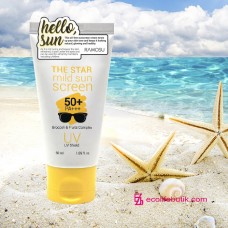The benefits and harm of sunlight.

Benefit:
- with a small amount of UV rays decreases collagen synthesis - this leads to the appearance of wrinkles and sagging skin;
- thanks to the sun is the development of vitamin D, necessary for the formation of bones;
- the sun's rays improve mood, strengthen the human immune system.
Harm:
With an excess of UV exposure, unpleasant consequences can occur - from burns to malignant tumors.
What types of rays affect human skin?
We are affected by two types of sunlight - UVA and UVB.
UVB - medium wave rays. They are 5%, since 95% of them are trapped by the ozone layer of the Earth. Under their influence is the stimulation of melanin production, which is responsible for the appearance of tan. It is their excess that can cause sunburn.
UVA - long wave beams. They are the most dangerous for the skin. When they are exposed, collagen is destroyed, which contributes to the early aging of the skin, stimulates melanin, and can provoke the occurrence of cancerous transformations of the skin.
What is SPF?
Sun Protect Factor (SPF) is a filter that provides protection against UVB rays. The number indicated on the sunscreen next to the SPF indicates the number of times 10-25 minutes you can be under the sun after using the SPF.
For example, if your skin needs 10 minutes to turn red, then SPF-15 will give you the opportunity to be in the sun, i.e. about 2.5 hours.
But this does not mean that the SPF 50 product will provide protection for the whole day, because all the anti-sun products must be reapplied after 2–3 hours.
What do high SPF sunscreens do?
They give better protection. Means with SPF 15 block 93% of UVB-rays, they need to be applied in a dense uniform layer. Means with SPF 30 - up to 97%, with SPF 50 up to 98%. The difference is not big, but fundamental.
The greater the SPF, the less damage our skin will cause solar radiation. Products with a high degree of protection are recommended to be applied to people with fair skin, children, those who have many moles.
When choosing a cream, you need to focus on the following factors:
- color of your skin (there are 6 color types: Celtic, light-skinned European, Central European, Mediterranean, Indonesian and African American);
- age (skin up to 35 years of age is better protected from the sun than at an older age, therefore, the older you are, the higher the level of UV protection must be);
- lifestyle (you spend the whole day in the office or on the street);
- skin condition (presence of moles, after aggressive cosmetic procedures, etc.);
- UV index in your area.
What is PA factor?
The PA (Protection Grade of UVA) factor provides protection against UV-A (long wavelength radiation). The principle of its measurement is similar to the measurement of SPF (assessment of the visible reaction of the skin)
The "+" signs after PA are shown for the amount of time until dark pigmentation appears. The more “+”, the better the protection means. In Korean means it is:
PA + - 2 hours;
PA ++ - 4 hours;
PA +++ - 8 hours of protection.
PA ++++ - more than 10 hours
Use quality tools! Take care of yourself!

